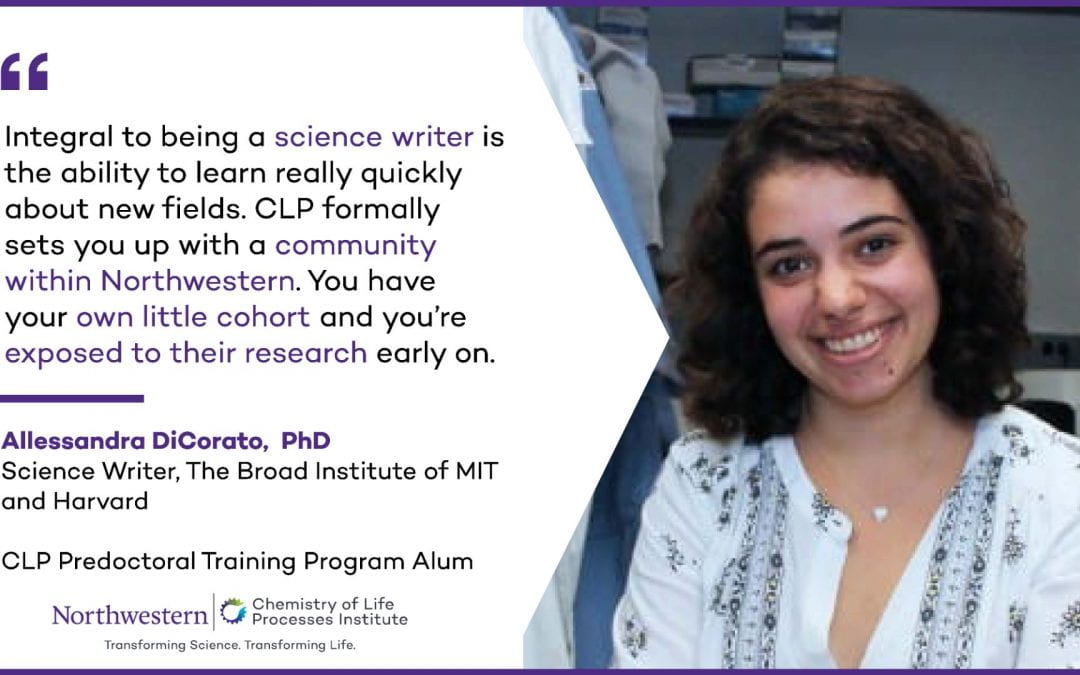Meet Allessandra DiCorato, PhD, science writer at The Broad Institute of MIT and Harvard. Allessandra is an alum of the Chemistry of Life Processes Institute Predoctoral Training Program and graduate of Northwestern’s Material Science and Engineering program. Her CLP training program preceptors were professors Derk Joester and Thomas O’Halloran.
What was the focus of your pre-doctoral research?
The goal of my research was to assemble a collection of imaging techniques that we could use to evaluate the delivery of different nanomaterial therapeutics to cancer cells and solid tumors. A lot of the nanomaterials that are developed in a lab setting don’t actually make it to FDA approval because there are so many preclinical and clinical trials that these drugs have to go through and so many different reasons that a drug could fail in a patient. If something goes wrong, it’s very difficult to tell why that drug failed. With our approach, we’ve found that a lot of techniques that are accessible in an academic setting can be used in combination to eliminate the various problems associated with studying the delivery of these nanomaterials to tumors.
What drew you to your first job out of graduate school and what are you doing now?
I have always been interested in writing. I was a creative writing minor in undergrad. When I came to grad school, writing was something that I really missed. So, I took a class at the Medill School of Journalism that was aimed at STEM students and was awarded a AAAS Mass Media Fellowship in 2019. I was placed at KQED, the NPR-member station in San Francisco, and spent a summer working with journalists there. I really loved the kind of writing I did for KQED and knew that when I came back to Northwestern, that’s what I wanted to do.
As a science writer at the Broad Institute of MIT and Harvard, I write for a number of different vehicles and for a variety of audiences. My responsibilities include writing stories for the internal newsletter that goes out to scientists every week, stories about recently published research, profiles of scientists, longer feature stories, and shorter pieces. I like that the Broad Institute bridges so many great academic institutions and places an emphasis on interdisciplinary and collaborative research. Coming from CLP and Northwestern, I know that collaboration is really important—it’s where the most exciting research happens.
How did CLP support your journey?
Integral to being a science writer is the ability to learn really quickly about new fields. CLP formally sets you up with a community within Northwestern. You have your own little cohort and are exposed to their research early on. CLP events educated me about what was going on and the resources that were available to me. I also got way better at talking about my research! My project came out of a collaboration that started with CLP. I’ve always appreciated that CLP emphasized that academia and industry are not the only careers that you can go into.
What was a highlight of your time at Northwestern?
Working at synchrotrons. You have to apply to get time on different instruments and it’s pretty competitive. Once you’re there, you have 24 hours a day to do experiments, but your team is with you and there are always scientists to help too. During my PhD, I was able to go to the Argonne National Laboratory’s Advanced Photon Source and the Swiss Light Source in Switzerland.
by Lisa La Vallee

